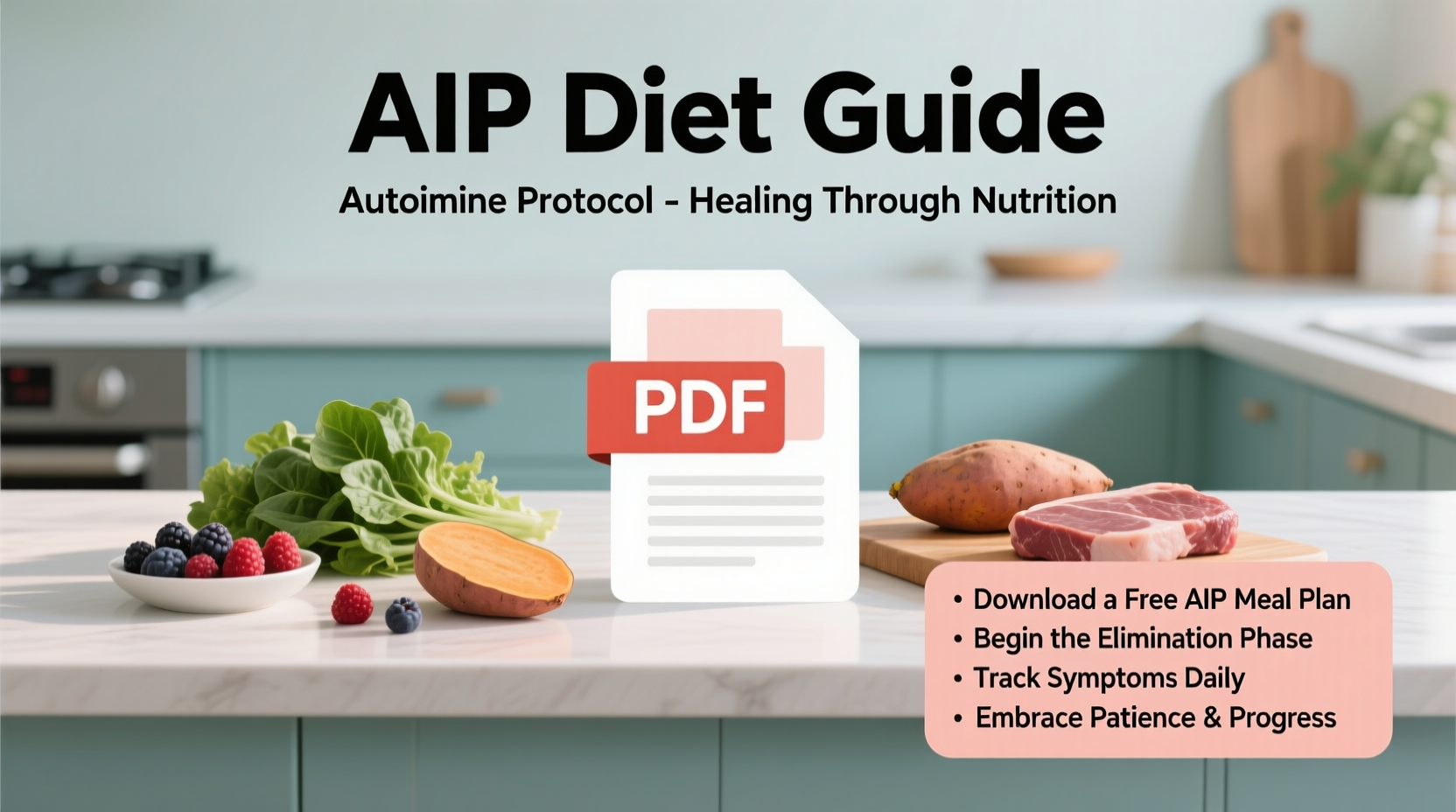Introduction
The Autoimmune Protocol (AIP) diet has emerged as a powerful tool for managing autoimmune conditions naturally. If you’re searching for an AIP diet plan PDF free resource, you’ve come to the right place. This comprehensive guide will walk you through everything you need to know about the AIP approach, from understanding its core principles to accessing valuable free resources that can kickstart your healing journey.
Whether you’re dealing with rheumatoid arthritis, Hashimoto’s thyroiditis, or inflammatory bowel disease, the AIP diet offers hope through targeted nutrition. We’ll explore how this evidence-based approach can help reduce inflammation, heal your gut, and potentially put your autoimmune symptoms into remission.
The Autoimmune Protocol (AIP) Diet
The AIP diet represents a specialized version of the paleo diet, specifically designed for people with autoimmune conditions. Unlike general elimination diets, AIP targets foods that commonly trigger immune responses and intestinal permeability.
This protocol works on the principle that certain foods can increase inflammation and worsen autoimmune symptoms. By removing these potential triggers for 30-90 days, then systematically reintroducing them, you can identify your personal food sensitivities.
The three-phase approach includes elimination, reintroduction, and maintenance phases. Each phase serves a specific purpose in your healing journey and requires different levels of dietary restriction.
Core Benefits of Following AIP
Research shows that the AIP diet can significantly reduce inflammatory markers in people with autoimmune conditions. Studies have documented improvements in inflammatory bowel disease symptoms, with some participants achieving clinical remission.
Many people report increased energy levels within the first few weeks of starting AIP. This improvement often stems from eliminating foods that were causing digestive distress and nutrient malabsorption.
Sleep quality frequently improves as inflammation decreases and blood sugar levels stabilize. Better sleep supports immune function and helps reduce stress hormones that can worsen autoimmune symptoms.
Joint pain and stiffness often diminish as inflammatory foods are eliminated. This improvement can be particularly noticeable for people with rheumatoid arthritis or other inflammatory joint conditions.
AIP Diet Phases Breakdown
Elimination Phase (30-90 Days)
During this initial phase, you’ll remove all potentially inflammatory foods from your diet. The duration depends on your individual response and symptom improvement.
Most people begin noticing changes within 2-4 weeks, though some may need longer. It’s crucial to stick with the elimination phase until you experience significant symptom improvement.
Track your symptoms daily using a journal or mobile app. Document energy levels, digestive issues, joint pain, skin problems, and sleep quality to monitor your progress effectively.
Reintroduction Phase (6+ Months)
Once your symptoms have stabilized and improved, you can begin systematically reintroducing eliminated foods. This phase requires patience and careful attention to your body’s responses.
Introduce one food at a time, consuming it for three days while monitoring for any adverse reactions. Wait 3-7 days between each new food introduction to allow time for delayed reactions to appear.
Common reintroduction order starts with foods least likely to cause problems, such as egg yolks, then progresses to more potentially problematic foods like nightshades and grains.
Maintenance Phase (Lifelong)
After completing reintroductions, you’ll have identified your personal trigger foods and can create a sustainable long-term eating plan. This phase focuses on maintaining your improvements while enjoying the widest possible food variety.
Regular check-ins with your symptoms help ensure you’re maintaining optimal health. Some people find they can tolerate previously problematic foods better after extended healing periods.
Foods to Include on AIP
Your AIP-compliant plate should feature high-quality proteins from grass-fed meats, wild-caught fish, and organ meats. These provide essential amino acids and nutrients like vitamin B12, iron, and zinc.
Colorful vegetables form the foundation of every meal, providing fiber, antioxidants, and phytonutrients that support immune function. Aim for 8-10 servings of vegetables daily across the color spectrum.
AIP-Approved Foods List:
- Grass-fed meats and poultry
- Wild-caught seafood
- Organ meats
- Leafy greens and cruciferous vegetables
- Colorful vegetables (except nightshades)
- Fermented foods like sauerkraut and kombucha
- Healthy fats (olive oil, coconut oil, avocado)
- Fresh herbs and AIP-approved spices
Foods to Avoid During Elimination
Grains and pseudo-grains are eliminated because they contain proteins that can trigger immune responses and increase intestinal permeability. This includes wheat, rice, quinoa, and buckwheat.
Legumes are removed due to their lectin and saponin content, which can irritate the digestive tract. Even seemingly healthy options like lentils and chickpeas are temporarily eliminated.
Complete AIP Elimination List:
| Food Category | Examples |
|---|---|
| Grains | Wheat, rice, oats, corn, quinoa |
| Legumes | Beans, lentils, peanuts, soy |
| Nightshades | Tomatoes, peppers, eggplant, potatoes |
| Dairy | Milk, cheese, yogurt, butter |
| Eggs | Whole eggs, egg whites, egg yolks |
| Nuts & Seeds | Almonds, chia seeds, flax seeds |
| Refined Sugar | White sugar, artificial sweeteners |
| Processed Foods | Anything with additives or preservatives |
Free AIP Diet Plan PDF Resources
Numerous websites offer comprehensive AIP diet plan PDF free downloads that include meal plans, shopping lists, and recipe collections. These resources can significantly simplify your AIP journey.
The Paleo Mom offers extensive free resources including food lists and reintroduction guides. Their scientifically-backed approach provides reliable information for beginners and experienced AIP followers alike.
Autoimmune Wellness provides free starter guides and meal planning templates. Their resources focus on practical implementation and sustainable lifestyle changes.
Many functional medicine practices offer free AIP guides as patient resources. These often include symptom tracking sheets and supplement recommendations from healthcare professionals.
Sample 7-Day AIP Meal Plan
Day 1-3 Example:
- Breakfast: Sweet potato hash with ground turkey and sautéed spinach
- Lunch: Salmon salad with mixed greens and avocado-lime dressing
- Dinner: Grass-fed beef stew with carrots, celery, and herbs
Day 4-7 Variation:
- Breakfast: Coconut flour pancakes with berries and coconut cream
- Lunch: Chicken bone broth soup with vegetables and fresh herbs
- Dinner: Baked cod with roasted Brussels sprouts and sweet potato
Snack options include fresh fruit, vegetable sticks with compliant dips, or homemade bone broth. Planning ahead ensures you always have AIP-compliant options available.
Shopping and Meal Prep Strategies
Successful AIP implementation requires strategic shopping and meal preparation. Focus on whole, unprocessed foods and read labels carefully to avoid hidden non-compliant ingredients.
Batch cooking saves time and ensures you always have compliant meals ready. Prepare large quantities of proteins, roasted vegetables, and AIP-friendly sauces on weekends.
Stock your pantry with AIP staples like coconut oil, olive oil, sea salt, and compliant herbs and spices. Having these basics available makes meal preparation much easier.
Tracking Progress and Success
Document your symptoms daily using a simple rating system or detailed journal entries. This information becomes invaluable during the reintroduction phase for identifying trigger foods.
Take progress photos and measurements alongside symptom tracking. Sometimes improvements in inflammation show up visually before you feel the changes internally.
Work with healthcare providers familiar with AIP when possible. They can help monitor biomarkers and provide guidance throughout your healing journey.
Conclusion and Next Steps
The AIP diet offers a structured, science-based approach to managing autoimmune conditions through nutrition. With the abundance of AIP diet plan PDF free resources available online, starting your healing journey has never been more accessible.
Begin by downloading a comprehensive AIP guide and meal plan from reputable sources. Start with the elimination phase and commit to tracking your symptoms consistently.
Remember that healing takes time, and everyone’s journey is unique. Be patient with yourself and celebrate small improvements along the way.
Frequently Asked Questions
Q: How long does it take to see results on the AIP diet?
A: Most people notice initial improvements within 2-4 weeks, though significant changes may take 2-3 months of strict compliance.
Q: Can I eat out while following AIP?
A: Yes, but it requires planning and communication with restaurant staff about ingredients and preparation methods to avoid cross-contamination.
Q: Is the AIP diet safe for children with autoimmune conditions?
A: AIP can be modified for children, but it should always be done under medical supervision to ensure proper nutrition and growth.
Q: What happens if I accidentally eat a non-compliant food during elimination?
A: One slip-up won’t ruin your progress, but you may need to extend your elimination phase by a few days to maintain steady improvement.
Q: Do I need supplements while following the AIP diet?
A: While AIP is nutrient-dense, some people benefit from specific supplements like vitamin D, omega-3s, or probiotics based on individual needs.





